General Information
Building Name: Delta Electronics (Americas), Ltd Headquarters Building Location: 46101 Fremont Blvd. Fremont, California, United States Project Size: Lot Area: 675,180 SF; Building Area: 172,405 SF Market Sector: Private Building Type: Office Delivery Method: Design-Build Total Building Costs: $86,000,000 Project Completion Date September 21, 2015 (move-in date) Date Building Occupied: December 22, 2016 (Certificate of Occupancy by City of Fremont) Has the building been occupied for a minimum of 1 year following completion? Yes
Project Team
Design Architect Joshua Jin Pan J.J. Pan and Partners 21, Alley 12, Lane 118 Ren Ai Road, Sec. 3 Taipei, Taiwan Country: Republic of China +886-2-27012617 panjih@jjpan.com
Architect on Record Jim Sunseri Korth Sunseri Hagey Architects 349 Sutter St. San Francisco, California 94108 415-954-1960 jsunseri@ksha.com
Landscape Architect Alec Hawley SWA Group 301 Battery Street, 2 Mezzanine North San Francisco, California 94111 415-836-8770 ahawley@SWAGroup.com
Civil Engineer Stephen Reynolds Kier & Wright Civil Engineers 2850 Collier Canyon Rd. Livermore, California 94551 925-245-8788 sreynolds@kierwright.com
Structural Engineer Kevin Menninger Nishkian Menninger 1200 Folsom St. San Francisco, California 94103 415-836-9301 kmenninger@nishkian.com
Geo Thermal Engineer Terry Proffer Major Geothermal 6285 West 48th Ave Wheat Ridge, Colorado 80033 303-424-1622 loopman@majorgeothermal.com
Mechanical Engineer Jonathon Bell ACCO Engineered Systems, Inc. 1133 Aladdin Ave. San Leandro, California 94577 510-346-4438 jbell@accoes.com
Electrical Engineer John Menicucci Morrow-Meadows Corp. 1050 Bing St. San Carlos, California 94070 650-634-0682 jmenicucci@morrow-meadows.com
Plumbing Engineer Rich Olson Cooper Preuit Engineers, Inc. 999 Saratoga Ave San Jose, California 95129 408-996-9577 rolson@cpeng.com
Geotechnical Engineer Sean Deivert Silicon Valley Soil Engineering 2391 Zanker Rd. STE 350 San Jose, California 95131 408-324-1400 sdeivert@siliconvalleysoil.com
Project Management John Hu Supex Construction 3130 Timber View Sugar Land, Texas 77479 713-660-8937 hujohnc@gmail.com
Contractor Bill Russell Vance Brown 3197 Park Boulevard Palo Alto, California 94306-2233 650-849-9900 b.russell@vancebrown.com
Green Building Consultant Thornton Tomasetti 650 California St. STE 1400 San Francisco, California 94108 415-365-6900
DESCRIPTION
The Delta Electronics (Americas) state-of-the-art, 178,000 square foot headquarters stands as a testament to Delta's commitment to the Americas market. Placed in the center of a growing tech industry hub in the Warm Springs area of Fremont, CA, the Delta symbol on an impressive glass building can be clearly seen from the Nimitz Freeway standing by peers, such as Tesla, Thermo Fisher Scientific, and more. The south side of the building faces salt ponds and the wall-to-wall windows frame a beautiful bay sunset every evening, while the north side faces East Bay's rolling hills—green in the winter and golden in the summer.
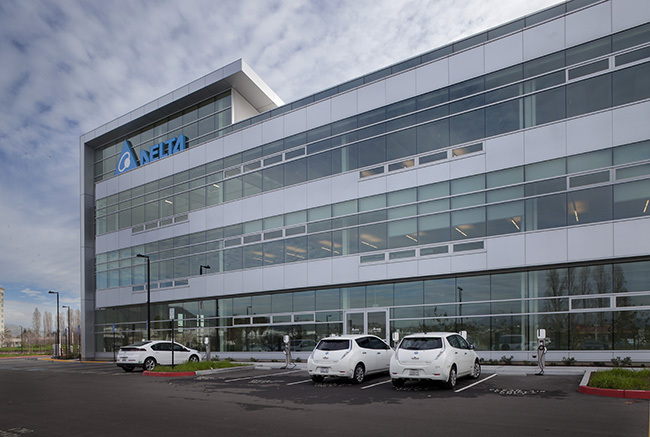
Glass façade that supports natural daylight goals and views.
Soon after completion in October of 2015, the facility earned LEED Platinum certification thanks to many of Delta's own leading technologies, which were incorporated into the design to achieve an elite level of sustainability. A 616kW rooftop PV system currently powers approximately 70 percent of the entire facility's annual energy consumption, and a 500kW bi-facial carport PV system combined with Delta's own energy storage system is projected to achieve net-zero energy consumption for many years to come once completed in March 2019. The office space is comprised of a North and South building complete with a data center, test labs, a showroom, and space for up to 500 employees, as well as a 40,000 sf. warehouse. On a lot that totals over 675,000 sf., every aspect was carefully designed with both sustainability and aesthetics in mind.
Delta's corporate mission is to provide innovative, clean, and energy-efficient solutions for a better tomorrow through products that allow for a reduction in energy consumption among corporations, homes, and communities across the globe. As such, a constant consideration throughout the design and building process was to ensure that the new Delta Electronics (Americas) headquarters followed this directive. To effectively demonstrate this and to serve as an example of sustainable corporate design that could be emulated across other enterprises, Delta set the ambitious goal of designing and building the first LEED Platinum Certified office in Fremont, California without compromising functionality, productivity, or aesthetics.
To achieve this, Delta utilized many of its own solutions and products. This served to demonstrate their capabilities and showcase different use-cases for generating savings, both in cost and carbon footprint. As such, countless different features that help save energy and water were installed, including the PV system with Delta's high efficiency solar inverters, a ground source heat pump, and bi-directional radiant heating and cooling system, active chilled beams, Delta's variable frequency drives, 18 of Delta's level 2 electric vehicle charging ports, and a 140,000–gallon rainwater harvesting tank.
With a lot that totaled over 675,000 sf., the Delta Electronics (Americas) headquarters was also to be aesthetically pleasing to the community, juxtaposing an impressive modern building design with the natural East Bay rolling hills in the background—all while maintaining a natural environment atmosphere.
Because of its carefully selected location, no matter what direction you look at the facility, you capture a natural background as well—whether it be the rolling hills, the salt ponds, or the ocean. Specially selected boulders from the American River in California were also brought in and placed at locations around the facility.
In addition to aesthetics, functionality and productivity were other focal issues for the design team. Facility operations were to be easily controlled by the facility's engineer and assisted by smart controls and automation, allowing the facilities and energy team to focus on other areas of energy waste and further reducing Delta's carbon footprint.
Cubicle partitions were lowered from 66" high-walled to 42" low-walled with 7" of glass on top to allow for more collaboration and free flow of ideas. For those that need more privacy, the building was designed with 25 meeting and conference rooms. An open-space atrium was created with skylights to allow for more casual meetings and great natural lighting. These also help to foster inter-departmental friendliness, which has increased social interactions and productivity.
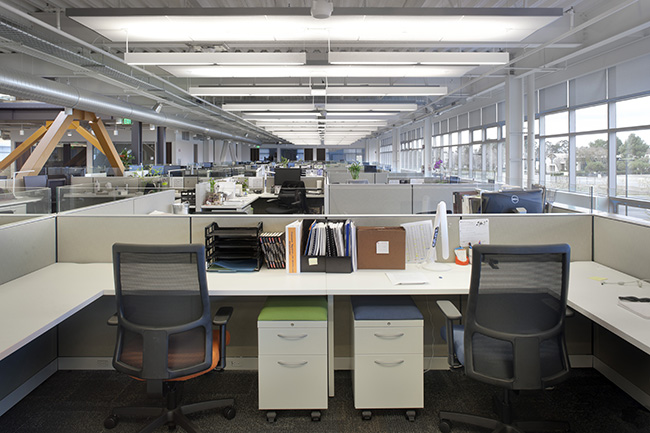
Natural light and views are not obstructed or blocked due to the lower cubicle partitions.
Overall Project Goal/Philosophy
"An enterprise exists and functions in a living environment that is closely connected to each of us. It should serve a higher goal of being responsible to society rather than just making profits." - Bruce Cheng, Founder and Honorary Chairman of Delta Electronics, Inc.
Accessible Goal The facility will be conveniently located by the 880 (Nimitz) Freeway. There will be handicap access and parking.
Aesthetic Goal The facility will maintain Delta's aesthetic, loosely following traditional Asian Feng Shui ideology, while also displaying the modernity and innovation of Silicon Valley's tech-industry.
Cost-Effective Goal The facility will capitalize on technology that is sustainable, and has returns on investment. By utilizing Delta's own products, the facility will be both cost-effective and green.
Functional Goal The facility will be monitored, metered, and automated where available to ensure smooth operations and comfortable occupants at all times.
Historic Preservation Goal The new facility headquarters will maintain the Delta status quo both aesthetically and through innovation. By remaining in Fremont, just a few miles away from the original Americas Headquarters, Delta will preserve its own history.
Productive Goal The facility will allow for more collaborative efforts, inter-department communication, and increased productivity.
Secure/Safe Goal Employees will be safe, secure, and comfortable in the facility.
Sustainable Goal The facility will achieve LEED Platinum certification by using the latest green technology and utilizing Delta's own products.
How the Project Team Worked to Deliver on the Project Goals As a project that was to be the first LEED Platinum commercial building in Fremont, every team involved was excited to collaborate without self-interests, which allowed for the project to not only satisfy, but set and reach new heights for sustainability, functionality, and aesthetics.
Distech Controls and Energy Online, a Delta-designed data analyst program, were among some of the main tools used to optimize facility operations and track energy consumption. In order to maximize utilization, the controls were programmed to allow for schedules, set-points, or manual control to operate lighting and temperature in the facility. Energy Online operates in conjunction with the meters to help track and visualize building energy consumption and production. This platform was also programmed to allow for later expansion in case submetering (subzone lighting, plug load, conference rooms, etc.) was desired.
The facilities and energy team continue to track and analyze building operations and energy data to monitor performance and compare it to benchmarks using software such as Energy Star's portfolio manager to ensure the facility is maintaining its status as a high-performance energy sustaining building.

View of the facility at night.
Process
Overview of Process
To ensure that the facility would meet the expected goals, the team interviewed many different architects and general contractors of all backgrounds to determine which teams would best fit the project and scope, as well as assess which groups would work well collaboratively before making the final selections. Once the decision on who to bring in was made, kick-off meetings and follow-up meetings were held at regular intervals until the design was finalized.
Pre-Design/Planning Activities After the finalization of the teams involved, kick-off meetings commenced with all of the consultants. The teams would brainstorm in the bi-weekly follow-up meetings. Consultants were encouraged to be as far-fetched and creative as possible (without regards to cost at this stage), to determine what sorts of ideas would come about. After this, the teams started to limit ideas to determine which ideas were cost-effective and could achieve the goals set within the budget. Because the scope was to design a facility that was as energy efficient as possible, finding solutions that met cost, design, and efficiency objectives was a challenge.
Design Activities Different energy models and ideas were brainstormed. Obstacles with permits and costs started to appear, such as dealing with the state water board due to adjacent wetlands, as well as working with the local Alameda Water District to redesign the geothermal loop from vertical to horizontal because the site did not meet the required depths for a vertical system.
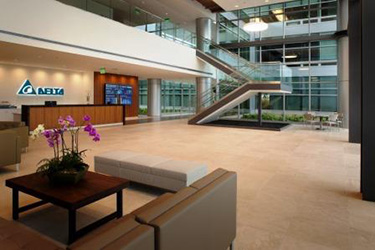

Lobby of the Headquarters.
Construction Activities Because of the many different features the facility was to demonstrate (geothermal boring, grading, underground utilities, foundation, trench work, tilt up panels, steel structure, plumbing, glass, radiant floor, rainwater harvesting tank, parking lot prep, boulders, sidewalks, irrigation, bioswales, lobby tiles, carpet, showroom, datacenter), there were many construction activities happening at the same time. Again, the teams involved were very willing to work together to ensure the goals were met. This was a very positive part of the process, as without the collaborative efforts of the teams involved, the project would have been extremely difficult to complete.

The exposed structural elements provide an interesting visual aesthetic experience of the spaces.
Operations/Maintenance Activities To ensure the facility was utilizing each of the features to its maximum potential, a significant amount of work and time was spent on optimizing the economizer, equipment runtimes, lighting controls/schedules, and expanding building automation.
Post-Occupancy Evaluation Activities To determine occupant satisfaction, UC Berkeley's Center for the Built Environment (CBE) program conducted a study and survey with the employees. The findings were very positive for many of the features surveyed (i.e. general satisfaction in the workplace, office furnishings, thermal comfort, air quality, lighting, acoustic quality, cleanliness and maintenance), with these elements of the building scoring standard-deviations above the benchmark.
Because of the building's sustainable design and high quality-of-life properties as evidenced by these results, the facility was given an Honorable Mention by UC Berkley's CBE as part of the 2017 Livable Buildings Award program. Project team leads also gave comments to evaluate the success of the different features. In addition, the corporate energy management team from Taiwan, the location of Delta Electronics' corporate headquarters, visited to continue energy auditing to further the search for areas of waste.
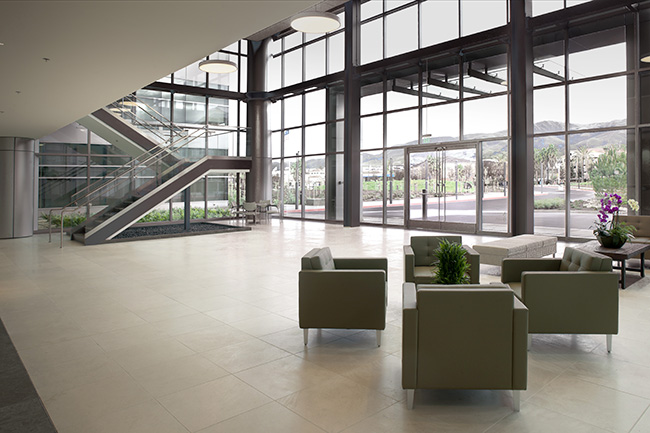
Open seating area receives ample daylight.
Information and Tools
Energy Simulation Software: Building energy simulation was done by Timmons Design using EnergyPro software
Other Tools: PVSyst software to simulate solar energy generation. Using these programs allowed for Delta to determine the size of the install needed to achieve its goals and to map out forecasts for energy production.
Products and Systems
- Delta Controls and LOYTEC Building Automation Systems (BAS) are used in the facility
- 20 percent of the building materials are reclaimed including steel, aggregate in concrete and millwork
- All wood elements are from FSC certified forests
- The Facility is built 20 percent above California Earthquake Standards
- 34 Clean-Air Vehicle parking spots
- 100 percent Fresh Air Ventilation
- Operable Skylights and Windows
PV Solar System Delta's current rooftop PV system, consisting of 2,464 Solar Panels and 28 of Delta's high efficiency Solar Inverters power approximately 70 percent of annual energy consumption. The company plans to install an additional 500kW bi-facial PV system that will enable the facility to achieve net-zero consumption for years to come.
HVAC Ground Source Heat Pump and Bi-Directional Radiant Heating Cooling Systems: The facility's geothermal heating and cooling system uses a ground source heat pump connected to a loop field of pipes located up to 30 feet underground. Heat is transferred to or from the ground to boost efficiency and achieve a 60 percent reduction in energy consumption compared to traditional HVAC systems. The ground source heat pump loops into the building's bi-directional radiant floor and ceiling tubes embedded in the concrete slabs. In total, there is more than 92 miles of pipe circulating 12,000 gallons of water.
Active Chilled Beams: Active chilled beams are installed in enclosed conference rooms and offices providing rapid cooling and quickly responding to room conditions to meet the set point temperature.Variable Frequency Drives Eighteen of Delta's energy-saving Variable Frequency Drives (VFDs), with up to 52 percent energy savings, are used in the following systems: Geothermal System, Heat Pumps, Chillers, Air Handling Units and Elevators.
EV Chargers Eighteen of Delta's own Level 2 7kW AC Chargers and one 50kW dual-standard Fast DC Charger were installed and remain available to employees and guests.
Smart Outdoor LED Parking Lot Lighting Sixty-three of Delta's energy-efficient LED Parking Lot Lights, with Zigbee communications, are installed throughout the parking areas, saving up to 53 percent energy compared to typical high-pressure sodium (HPS) lights.
Energy Management Delta's Energy Online platform provides real-time and historical energy data displays, data analysis reports, device management, and system monitoring to effectively capture internal energy information and ensure accurate tracking against energy savings benchmarks.
ENERGY ISSUES
Energy Use Description
The company's core focus in building the facility was to be as energy efficient as possible. Delta incorporated as many of its own products and features as possible to achieve this. Daylight was also maximized by using floor-to-ceiling windows around the facility and in conference rooms, taking the orientation of the facility into account, using daylight sensors, and including skylights in the atrium area. Delta also incorporated automated heating, cooling, and lighting controls based on set-points and schedules to minimize waste. Radiant flooring and active chilled beams were also added to the office space, and a geothermal (ground-sourced heat pump) system incorporated in lieu of a traditional cooling tower to optimize heating and cooling.
Annual Energy Use by Fuel Electricity: Average 446,626 kWh Gas: Average of 13.3M BTU (3,926 kWh) Total: 450,552 kWh
Annual On-Site Renewable Generation PV: Average 805,000 kWh Total: 805,000 kWh
Peak Use: Peak Electricity Demand: 92 kWh
Data Sources and Reliability Based on simulation? Yes If yes, list software and versions. Delta Energy Online (ver. 3.1) Based on utility bills? Yes If yes, please list company or companies and dates of bills. PG&E 2015—Current
Indoor Environment
Indoor Environment Approach
The team collaborated with UC Berkeley's Center for the Built Environment (CBE) to determine indoor environment quality and, in 2016, Delta employees took part in the CBE Occupant Indoor Environmental Quality Survey. As one of the top scorers in the survey, Delta's Americas headquarters was one of six facilities selected as a finalist for CBE's Annual Livable Buildings Award.
Areas in need of improvement were studied through further collaborations with CBE as well as independent experiments (CO2, light, temperature sensors) to determine potential solutions.
Project Results / Lessons Learned
Accessible: The Delta Americas Headquarters is located conveniently next to the 880 Nimitz Freeway and has multiple entry points for employees, visitors, and delivery trucks. There are also 12 handicap parking spaces.
Aesthetics: River rocks were specially picked out from the American River and placed around the area juxtaposed to the modern features of the facility. This creates an aesthetically pleasing contrast that emphasizes the natural landscape and environment.
Cost-Effective: By utilizing Delta's own high efficiency products, LEED Platinum certification was achieved within budget.
Functional / Operational: Many of Delta's building operations are automated or optimized for the facility engineer's ease of use, saving time and freeing up facility staff to focus on more complex waste-saving initiatives.
Historic Preservation: The facility preserves many of Delta's Eastern-inspired traditions, with some alterations to be more sustainable. For example, replacing the tradition Delta koi fish pond with a dry "stone river."
Productive: The atrium in the office area provides employees with an informal space to hold meetings or a quiet place to work under the natural light provided by the operable skylights. Furthermore, lowered cubicle partitions allow for more inter-department social interactions and maximizes natural light. A mile-long walkway around the facility along with an exercise and activity room encourages people to keep active.
Secure / Safe: The Delta Electronics (Americas) headquarters was designed 20 percent above California Earthquake Standards. Access is allowed to employees via a key scanner at multiple locations around the facility, and visitors enter through the front doors. Safety and preventative maintenance is frequent to ensure there is no lapse in employee and visitor safety.
Sustainable: The initial goal of meeting LEED Platinum certification was met soon after occupant certification was granted. After meeting this goal, a new mission to reach net-zero was set, an achievement that will be accomplished in 2019 after the 500 kW bi-facial solar carport is complete.
In addition to utilizing Delta's own green products to reach the building's sustainability goals, 20 percent of the building materials are reclaimed, including steel, aggregate in concrete and millwork. Additionally, all wood elements are from Forest Stewardship Council (FSC)- certified forests.
Additionally, there are 34 clean air vehicle parking spots, of which 18 are EV charging ports, free for employee use. Delta plans to add 28 more EV charging ports with the completion of the solar carport in 2019.
EVALUATION
Design Trade-Offs and Interactions
Delta was able to successfully navigate unforeseen hurdles within the design and execution of the facility. Of note, Delta faced the challenges of installing a state-of-the-art geothermal system, given the facility did not reside on a deep enough lot to effectively construct a vertical system. Knowing that HVAC improvements such as this would account for a large portion of energy savings, Delta creatively overcame this challenge using a horizontal geothermal system. While this required extensive piping to cover the length of the facility—the size of five football fields—it only needed to reach a vertical length of 30 feet, resolving the geographical challenge of the site's limited depth.
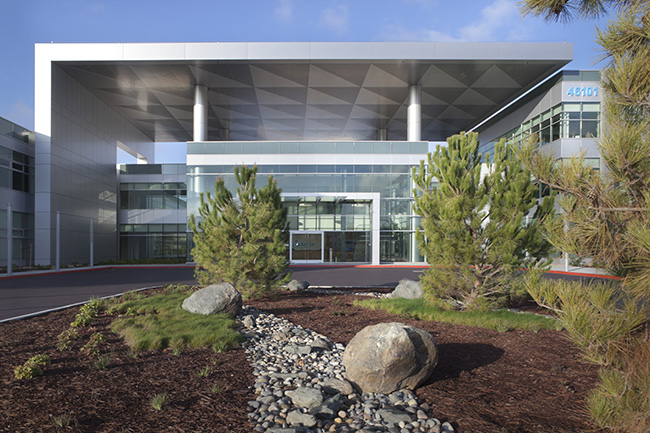
Close up of the entrance including some of the site plantings.
Positive and Negative Aspects of the Process
One of the conflicts that came into play was the allotted budget. Delta set ambitious energy efficiency and design goals, forcing the team to prioritize which of the many cutting-edge features would be implemented. Fortunately, the team was able to do so effectively, without letting conflicts of interest hinder their decisions and the project's progress. Another challenge was trying to implement as many Delta products as possible while also considering where they were in the design process. For example, some of Delta's newest products would have fit well in the facility but were not ready or certified at the time.
How Building Materials, Systems and Product Selection Addressed the Design Objectives, Goals and Strategies
To accomplish LEED Platinum Certification, certain checkpoints had to be verified. For materials and resources, construction waste management, recycled content, and the utilization of regional materials and certified wood were awarded. In addition to this, 32 of 35 of the U.S Green Building Council's (USGBC) Energy and Atmosphere checkpoints were awarded, among them full scores in Optimizing Energy performance, On-Site Renewable Energy, Enhanced Commissioning, Enhanced Refrigerant Management, and Green Power.

Main entrance.
How the Project Addressed Existing Site Conditions and Context, Including the Surrounding Community
Because of the facility's location, the orientation of the geothermal pumps had to be changed from vertical (traditional style) to horizontal. Being located by warm springs also meant higher ground temperatures than average which meant that the purpose for the geothermal pumps would be different than traditional systems. Active aquafers in the ground forced the team to change water treatment solutions from nitrite, the industry standard, to a phosphate solution, both of which are used to inhibit corrosion.
Synergies that Resulted from the Strategies Implemented
A combination of geothermal, condenser water, radiant flooring, and active chilled beams continue to work well together to further reduce the energy consumption for each of the systems. Building control platforms for facility operations allowed for ease of use and have helped to ensure comfort for occupants.
How the Performance of the Building Was Measured or Evaluated
- LEED Platinum Certification
- CBE Occupant Indoor Environmental Quality Survey
- Energy Star portfolio manager for benchmarking
How The Owner/Client and Community Benefited
With the completion of the Delta Electronics (Americas) Headquarters, the facility became one of twenty-six (26) Delta established green buildings and 1 certified green data center, highlighting Delta's commitment to building an environmentally sustainable future. The office space also expanded to allow for up to 500 occupants. The community was able to benefit by the addition of hundreds of career opportunities, with minimal carbon footprint added to the environment.
REFERENCES
Ratings
- LEED Platinum Certification—Sept. 2016
Awards
- NECA Project Excellence Award—Sept 2016
- UC Berkley's Center for the Built Environment 2017 Livable Buildings Award program—August 2017
Publishing
- The Delta Electronics (Americas) Headquarters has been featured in nearly 30 different local and trade publications. These sites in total attract 32 million monthly unique visitors per month. A full list of hyperlinked coverage can be found in the accompanying document titled Delta Electronics (Americas) Media Coverage .










